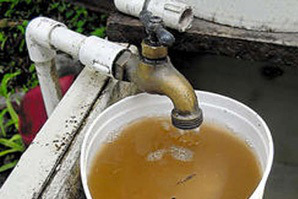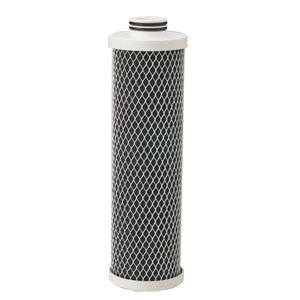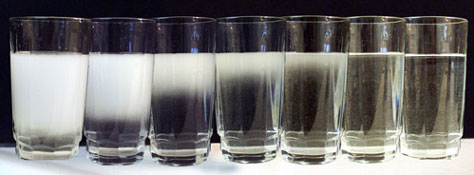Turbidity
Pure Water Gazette Technical Writer Pure Water Annie Clears Up Turbidity
Turbidity can be thought of as the general cloudiness of water. It is actually a measurement of the degree to which particulate in the water interferes with light transmission. Suspended particles absord and diffuse light.
High turbidity can be identified without a water test.
A turbidity test uses an instrument that passes light through the water and measures the amount of interference from suspended particles.The turbidity test reports results on an artificial scale using nephelometric units, or ntu. Anything above one ntu is technically an EPA “action level” violation, although the human eye only begins to detect turbidity in water at about 4 ntu. Therefore, water that appears completely clear to the eye can have excessive turbidity with health implications.
Turbidity in groundwater is often from tiny mineral particlses. These can include precipitated iron, clay particles or calcium carbonate precipitation. In surface water turbidity is more likely suspended organic matter or other sediment.
The level of turbidity can, of course, range from invisible to the eye to highly colored water that is not transparent.
Turbidity in water is more than an aesthetic issue. It is a frequent indicactor of microbial contamination because microbes can attach themselves to suspended sediment. Turbidity also makes it more difficult to disinfect water with chemicals. The same is true with UV treatment because suspended particles can shadow microbial contaminants protecting them for the germicidal effect of the UV lamp.
Residential sediment treatment can range from the “sand trap” shown above, which relies on gravity to drop large particles from the water, to extremely tight membrane filters that can screen out sub-micron sized particles.
Treatment for turbidity is mainly by filtration. Sediment filters can be cartridge style, granular beds, or membrane-style. With large particles, simply holding the water in a tank will allow particulate to settle out. In municipal treatment, settling and filtration are often aided by chemicals like alum which promote coagulation and flocculation of small particles to form larger particles that settle or are filtered easily. The very tiniest if particles can be treated by membrane technologies like microfiltration, ultrafiltration, nanofiltration, and reverse osmosis.
This “microguard” cartridge filters out particulate (as well as bacteria and cysts) down to a very tight 0.15 micron absolute.
It is important to realize that turbidity in water is not just an aesthetic consideration. While crystal clear water is certainly more appealing to the eye and to the palate, turbidity is also an important health consideration because microbes thrive in unclean water. Even if water appears clear, it is a good idea to test for turbidity and to take high turbidity readings seriously.
When cloudy water clears from the bottom upward as in the picture, the problem is not physical particulate but simply excess air trapped in the water. This sometimes occurs when carbon filters are new.
Commonly used sediment filters:
Simple wound string, spun polypropylene and pleated cartridge filters. These are available in a large range of “tightness” ratings that are stated in “microns.” Cartridge filters range in size from tiny to very large. Probably the most common residential whole house sediment filter is the popular ten-inch “Big Blue.”
“Spin down” separators that are usually measured by “mesh” size. These have long lasting screens that are cleaned by simple blow down process.
“Sand traps” that allow large particles to drop from the water into a specially designed filter tank.
Backwashing filters that contain specialty media designed to trap sediment. The newer natural zeolite media can filter down to 5 microns.




![pwanniemedium[1]](http://www.purewatergazette.net/blog/wp-content/uploads/2012/05/pwanniemedium1-246x300.jpg)




